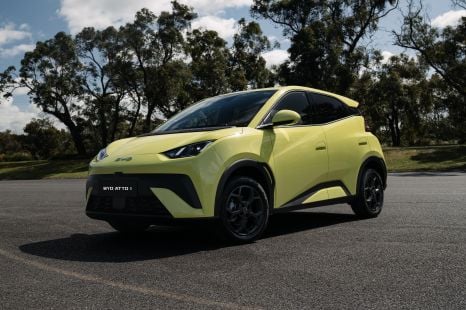

William Stopford
2026 Ford Ranger Super Duty deliveries starting early in Australia
7 Hours Ago

Journalist
The seven-seat Kia Telluride SUV has become the first South Korean car to win World Car of the Year, beating out two Mazdas for the title.
Kia would usually be honoured at a breakfast in New York, but the COVID-19 pandemic turned made this year’s World Car of the Year event online-only.
The judges saw the Telluride finish 13 points ahead of the Mazda 3, with the Mazda CX-30 a further seven points behind in third place.

Measuring five metres long, the Telluride shares a platform with the Hyundai Palisade. It’s the the largest-ever Kia SUV and features up to eight seats across three rows.
It is powered exclusively by a 3.8-litre V6 with 217kW ofpower and 355Nm oftorque, hooked up to all- or front-wheel drive with an eight-speed automatic transmission.
Built in West Point, Georgia in the USA, the Telluride is currently reserved for North America.

Although it was developed for left-hand drive markets, the Hyundai Palisade with which the Telluride shares its platform is earmarked for a 2020 arrival in Australia.
Damien Meredith, Kia Australia’s chief operating officer, called the company’s winners “two very special individual models”.
“While it is true that neither Telluride nor the Soul EV is available to Australia at the moment, you never say never in such a dynamic industry,” Meredith said.
“Circumstances change and we will never close the door on any possibility.”
The Porsche Taycan (below) blitzed the field to become the 2020 World Luxury Car of the Year.
In the end it was 60 points clear of the Porsche 911 in second place, with the Mercedes-Benz EQC rounding out the podium.

The Taycan’s second gong this year was World Performance Car of the Year. The 911 once again played bridesmaid, while the Toyota Supra finished third.
At present the Taycan range begins with the 390kW/640Nm 4S, and is topped by the 560kW/1050Nm Turbo S which, of course, is not fitted with a turbo.
Seen as a Tesla Model S competitor, the Taycan is the first pure-electric Porsche.
The Taycan is scheduled to arrive Down Under during the final quarter of 2020, although the current coronavirus pandemic might delay its local launch.

In the World Urban Car category, the Kia Soul EV (above) took first place ahead of the Volkswagen T-Cross. Both finished at least 125 points ahead of the third-placed electric Mini Cooper SE.
With a 150kW/395Nm electric motor connected to the front wheels, the new Soul EV is significantly more powerful than the car it replaces.
Perhaps more importantly, the 64kW lithium-polymer battery offers double the capacity of its predecessor.

Finally, the Mazda 3 (above) was awarded World Car Design of the Year.
The Mazda finished just two points clear of the Taycan, denying the electric Porsche its third prize for the day. The new Peugeot 208 finished third.
While the Mazda 3’s exterior and interior design has been widely praised, the elimination of more affordable models, as well as the continued drift towards crossover vehicles, has seen sales drop significantly.
There were 24,939 Mazda 3 sedans and hatches sold in Australia last year, a drop of 19.7 per cent compared to 2018.
By contrast the segment-topping Toyota Corolla only fell 13.7 per cent, while the Hyundai i30 actually increased sales marginally.

Carlos Tavares (above) was named as the 2020 World Car Person of the Year.
The CEO of the PSA Group was praised for returning the Opel and Vauxhall brands to profit in 2018, around a year after the French automaker bought the marques from GM.
Opel and Vauxhall last recorded a profit in 1999.
Tavares last year successfully negotiated a merger between PSA and Fiat Chrysler.
When the merger is completed, likely in 2021, the Peugeot, Citroen, DS, Opel, Vauxhall, Fiat, Alfa Romeo, Maserati, Lancia, Chrysler, Dodge, Ram and Jeep brands will all reside under one roof.
Where expert car reviews meet expert car buying – CarExpert gives you trusted advice, personalised service and real savings on your next new car.
Derek Fung would love to tell you about his multiple degrees, but he's too busy writing up some news right now. In his spare time Derek loves chasing automotive rabbits down the hole. Based in New York, New York, Derek loves to travel and is very much a window not an aisle person.


William Stopford
7 Hours Ago


Paul Maric
7 Hours Ago


William Stopford
7 Hours Ago


William Stopford
7 Hours Ago


William Stopford
7 Hours Ago


Ben Zachariah
9 Hours Ago